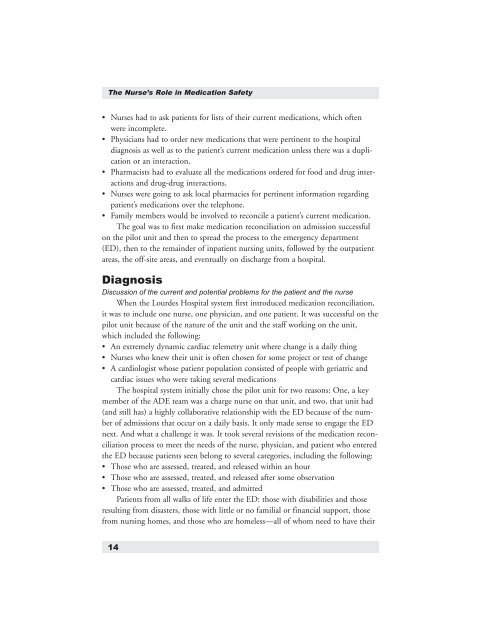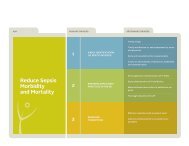The Nurse's Role in Medication Reconciliation - BC Patient Safety ...
The Nurse's Role in Medication Reconciliation - BC Patient Safety ...
The Nurse's Role in Medication Reconciliation - BC Patient Safety ...
You also want an ePaper? Increase the reach of your titles
YUMPU automatically turns print PDFs into web optimized ePapers that Google loves.
<strong>The</strong> Nurse’s <strong>Role</strong> <strong>in</strong> <strong>Medication</strong> <strong>Safety</strong><br />
• Nurses had to ask patients for lists of their current medications, which often<br />
were <strong>in</strong>complete.<br />
• Physicians had to order new medications that were pert<strong>in</strong>ent to the hospital<br />
diagnosis as well as to the patient’s current medication unless there was a duplication<br />
or an <strong>in</strong>teraction.<br />
• Pharmacists had to evaluate all the medications ordered for food and drug <strong>in</strong>teractions<br />
and drug-drug <strong>in</strong>teractions.<br />
• Nurses were go<strong>in</strong>g to ask local pharmacies for pert<strong>in</strong>ent <strong>in</strong>formation regard<strong>in</strong>g<br />
patient’s medications over the telephone.<br />
• Family members would be <strong>in</strong>volved to reconcile a patient’s current medication.<br />
<strong>The</strong> goal was to first make medication reconciliation on admission successful<br />
on the pilot unit and then to spread the process to the emergency department<br />
(ED), then to the rema<strong>in</strong>der of <strong>in</strong>patient nurs<strong>in</strong>g units, followed by the outpatient<br />
areas, the off-site areas, and eventually on discharge from a hospital.<br />
Diagnosis<br />
Discussion of the current and potential problems for the patient and the nurse<br />
When the Lourdes Hospital system first <strong>in</strong>troduced medication reconciliation,<br />
it was to <strong>in</strong>clude one nurse, one physician, and one patient. It was successful on the<br />
pilot unit because of the nature of the unit and the staff work<strong>in</strong>g on the unit,<br />
which <strong>in</strong>cluded the follow<strong>in</strong>g:<br />
• An extremely dynamic cardiac telemetry unit where change is a daily th<strong>in</strong>g<br />
• Nurses who knew their unit is often chosen for some project or test of change<br />
• A cardiologist whose patient population consisted of people with geriatric and<br />
cardiac issues who were tak<strong>in</strong>g several medications<br />
<strong>The</strong> hospital system <strong>in</strong>itially chose the pilot unit for two reasons: One, a key<br />
member of the ADE team was a charge nurse on that unit, and two, that unit had<br />
(and still has) a highly collaborative relationship with the ED because of the number<br />
of admissions that occur on a daily basis. It only made sense to engage the ED<br />
next. And what a challenge it was. It took several revisions of the medication reconciliation<br />
process to meet the needs of the nurse, physician, and patient who entered<br />
the ED because patients seen belong to several categories, <strong>in</strong>clud<strong>in</strong>g the follow<strong>in</strong>g:<br />
• Those who are assessed, treated, and released with<strong>in</strong> an hour<br />
• Those who are assessed, treated, and released after some observation<br />
• Those who are assessed, treated, and admitted<br />
<strong>Patient</strong>s from all walks of life enter the ED: those with disabilities and those<br />
result<strong>in</strong>g from disasters, those with little or no familial or f<strong>in</strong>ancial support, those<br />
from nurs<strong>in</strong>g homes, and those who are homeless—all of whom need to have their<br />
14



